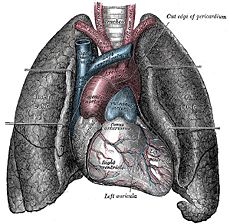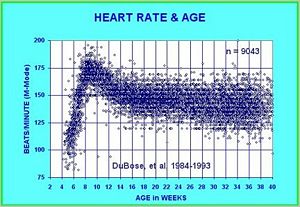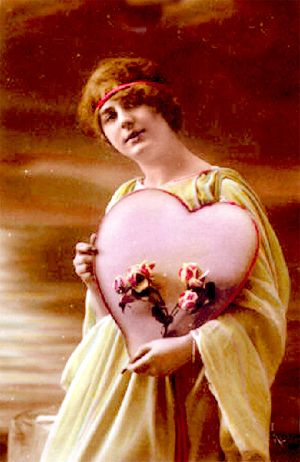Heart
The heart is a hollow, muscular organ in vertebrates, responsible for pumping blood through the blood vessels by repeated, rhythmic contractions, or a similar structure in annelids, mollusks, and arthropods. The term cardiac (as in cardiology) means "related to the heart" and comes from the Greek καρδιά, kardia, for "heart." The heart is composed of cardiac muscle, an involuntary muscle tissue which is found only within this organ.
Early development
The human embryonic heart begins beating approximately 21 days after conception, or five weeks after the last normal menstrual period (LMP), which is the date normally used to date pregnancy. The human heart begins beating at a rate near the mother’s, about 75-80 beats per minute (bpm). The embryonic heart rate (EHR) then accelerates linearly for the first month of beating, peaking at 165-185 bpm during the early 7th week, (early 9th week after the LMP). This acceleration is approximately 3.3 bpm per day, or about 10 bpm every three days, an increase of 100 bpm in the first month. [1]
After peaking at about 9.2 weeks after the LMP, it decelerates to about 150 bpm (+/-25 bpm) during the 15th week after the LMP. After the 15th week the deceleration slows reaching an average rate of about 145 (+/-25 bpm) bpm at term. The regression formula which describes this acceleration before the embryo reaches 25 mm in crown-rump length or 9.2 LMP weeks is:
Age in days = EHR(0.3)+6
See: Embryonic Heart Rates Compared in Assisted and Non-Assisted Pregnancies
There is no difference in male and female heart rates before birth.[1]
Structure
In the human body, the heart is normally situated slightly to the left of the middle of the thorax, underneath the breastbone (see diagrams). The heart is usually felt to be on the left side because the left heart (left ventricle) is stronger (it pumps to all body parts). The left lung is smaller than the right lung because the heart occupies more of the left hemithorax. The heart is enclosed by a sac known as the pericardium and is surrounded by the lungs. The pericardium is a double membrane structure containing a serous fluid to reduce friction during heart contractions. The mediastinum, a subdivision of the thoracic cavity, is the name of the heart cavity.
The apex is the blunt point situated in an inferior (pointing down and left) direction. A stethoscope can be placed directly over the apex so that the beats can be counted. This physical location is between the sixth and seventh rib, just to the left of the sternum [2]. In normal adults, the mass of the heart is 250-350 g (9-16 oz), but extremely diseased hearts can be up to 1000 g (2 lb) in mass due to hypertrophy. It consists of four chambers, the two upper atria (singular: atrium ) and the two lower ventricles. On the left is a picture of a fresh human heart which was removed from a 64-year-old British male.
The function of the right side of the heart (see right heart) is to collect deoxygenated blood, in the right atrium, from the body and pump it, via the right ventricle, into the lungs (pulmonary circulation) so that carbon dioxide can be dropped off and oxygen picked up (gas exchange). This happens through a passive process called diffusion. The left side (see left heart) collects oxygenated blood from the lungs into the left atrium. From the left atrium the blood moves to the left ventricle which pumps it out to the body. On both sides, the lower ventricles are thicker and stronger than the upper atria. The muscle wall surrounding the left ventricle is thicker than the wall surrounding the right ventricle due to the higher force needed to pump the blood through the systemic circulation.
Regulation of the cardiac cycle
Cardiac muscle is myogenic (able to contract and relax on its own). It is a specialized muscle found nowhere else but in the heart because it has its own conducting system. This is in contrast with skeletal muscle, which requires either conscious or reflex nervous stimuli. The heart's rhythmic contractions occur spontaneously, although the waves or nerves can be changed by nervous frequency influences such as exercise or the perception of danger.
The rhythmic sequence of contractions is coordinated by the sinoatrial and atrioventricular nodes. The sinoatrial node, often known as the cardiac pacemaker, is located in the upper wall of the right atrium and is responsible for the wave of electrical stimulation (See action potential) that initiates atria contraction. Once the wave reaches the atrioventricular node, situated in the lower right atrium, it is conducted through the bundles of His and causes contraction of the ventricles. The time taken for the wave to reach this node from the sinoatrial nerve creates a delay between contraction of the two chambers and ensures that each contraction is coordinated simultaneously throughout all of the heart. In the event of severe pathology, the Purkinje fibers can also act as a pacemaker; this is usually not the case because their rate of spontaneous firing is considerably lower than that of the other pacemakers and hence is overridden
Other physiological functions
The heart also secretes atrial natriuretic factor (ANF), a powerful peptide hormone that affects the blood vessels, the adrenal glands, the kidneys, and the regulatory regions of the brain in order to regulate blood pressure and volume.
First aid
See cardiac arrest for emergencies involving the heart
If a person is encountered in cardiac arrest (no heartbeat), cardiopulmonary resuscitation (CPR) should be started, and help called. If an automated external defibrillator is available, this device may automatically administer defibrillation if this is indicated.
The hearts of other animals
Vertebrates
The hearts of fish have only two chambers: one atrium and one ventricle. In fish, the system has only one circuit. The blood pumps through the gills and on to the bodily tissues before returning to the heart.
Amphibians and most reptiles have a three-chambered heart, in which oxygenated blood from the lungs and de-oxygenated blood from the respiring tissues enter by separate atria, and are directed via a spiral valve to the appropriate vessel—aorta for oxygenated blood and pulmonary artery for deoxygenated blood. The spiral valve is essential to keeping the mixing of the two types of blood to a minimum, enabling the animal to have higher metabolic rates, and be more active than otherwise.
Mammals (a class of vertebrate), birds and crocodiles show complete separation of the heart into two pumps, for a total of four heart chambers; it is thought that the four-chambered heart of birds evolved independently of that of mammals.
Invertebrates
Many invertebrates, such as bivalves and arthropods, exhibit an open circulatory system where blood flows both in vessels and freely in the body cavity. In these animals the blood usually collects in a series of specialised sinuses, or cavities, where it directly comes in contact with tissues. It is then returned to the heart and is again released into the body.
The earthworm doesn't have a heart; it has five aortic arches that serve the same purpose.
Heartbeat
Smaller animals have faster heartbeats. This is evident within a species as well, as the young beat their hearts faster than the adults. See "Early development" above for information about the early human heart rates.
The Gray Whale's heart beats 9 times per minute, Harbour Seal 10 when diving, 140 when on land, elephant 25, human 72, sparrow 500, shrew 600, and hummingbird 1,200 when hovering. These heart rates usually vary on the animal's ratio of surface area to body mass; an elephant with relatively less surface area than a mouse loses proportionally less heat and requires comparatively less blood to be pumped throughout their body. An ectothermic animal will usually have a slower, and more variable heartbeat than an endothermic animal of similar size.
Food use
The hearts of cattle, sheep, pigs, chickens and certain fowl are consumed as food in many countries. They are counted among offal, but being a muscle, the taste of heart is much more like regular meat than that of other offal. It resembles venison in structure and taste.
"Heart" as a symbol
The heart (♥) has long been used as a symbol to refer to the spiritual, emotional, moral, and in the past also intellectual core of a human being. As the heart was once widely believed to be the seat of the human mind, the word heart continues to be used poetically to refer to the soul, and stylized depictions of hearts are extremely prevalent symbols representing love. However, more realistic depictions of human hearts tend to have macabre connotations of death and violence, quite unlike the concepts associated with the poetic and symbolic heart. This discrepancy is a common source of dark humor.
In mythology, spirituality and religion
In religious texts such as the Bible [3], the heart has historically been ascribed much mystical significance, either as metaphor or as an organ genuinely believed to have spiritual or divine attributes.
In the Bible, this idea emerges in the earliest passages; Genesis 6:5 situates the thoughts of evil men in their hearts, and Exodus 5 through 12 speak repeatedly of the Lord "hardening Pharaoh's heart." By this it is meant that God made Pharaoh resolve not to let the Israelite slaves leave Egypt, in order to bring judgment against Pharaoh and demonstrate his power: "'Go to Pharaoh, for I have hardened his heart and the hearts of his officials so that I may perform these miraculous signs of mine among them'" (Exodus 10:1).
In the Book of Jeremiah 17:9, it is written that the "heart is deceitful above all things, and desperately wicked," and that the Lord is the judge who "tries" the human heart.
Similarly, in Egyptian mythology, the heart was weighed in a balance against the feather of Ma'at, symbolising truth, in the judgment of the dead in the Egyptian Book of the Dead. Should the heart be heavier than the feather, the judged person would suffer in hell, since his heart was weighed down with sins. However, if the heart was lighter than the feather, the owner of the heart was admitted to paradise (See also Egyptian soul).
In early science and philosophy
Many classical and medieval philosophers and scientists, including Aristotle, considered the heart the seat of thought, reason or emotion, often rejecting the value of the brain.
The Roman physician Galen located the seat of the passions in the liver, the seat of reason in the brain, and considered the heart to be the seat of the emotions. While Galen's identification of the heart with emotion were proposed as a part of his theory of the circulatory system, the heart has continued to be used as a symbolic source of human emotions even after the rejection of such beliefs.
The Stoics taught that the heart was the seat of the human soul.
As icon
In European traditional art and folklore, the heart symbol is drawn in a stylized shape. This shape is typically colored red, suggesting both blood and, in many cultures, passion and strong emotion. It and diamonds are the two red suits in most playing card decks. The shape is particularly associated with romantic poetry; it is often seen on St. Valentine's Day cards, candy boxes, and similar popular culture artifacts as a symbol of romantic love.
What the traditional "heart shape" actually depicts is a matter of some controversy. It only vaguely resembles the human heart. Some people claim that it actually depicts the heart of a cow, a more readily available sight to most people in past centuries than an actual human heart. However, while beef hearts are more similar to the iconic heart shape, the resemblance is still slight. The shape does resemble that of the three-chambered heart of the turtle, and that of the human male prostate gland, but it is very unlikely that the image was patterned after either of these organs.
The "heart" shape could also be considered to depict features of the human female body, such as the female's pubic mound or vulva. A Sumerian cuneiform symbol for "woman" closely resembles the heart shape, and is believed to directly depict the pubic mound. Others maintain that the heart resembles the shape of the female breasts or the female buttocks.
Another possible origin can be seen on the coins of the ancient city of Cyrene, some of which depict the seeds or fruit of the now-extinct silphium plant. The seeds are distinctly heart-shaped. Since this plant was widely used as an ancient herbal contraceptive or abortifacient, this shape may have come to be associated with sexuality and love.
The most common emoticon for the heart is <3. In Unicode, the heart symbol is U+2665, and it can thus be generated in HTML by typing ♥ or ♥, or by the HTML entity ♥. Mathematically, a heart-shaped figure, called a cardioid, can be represented by plotting a graph of either or, in polar form,
ReferencesISBN links support NWE through referral fees
- ↑ Terry J. DuBose Sex, Heart Rate and Age
See also
- Artificial heart
- Atrium
- Blood pressure
- Cardiology
- Cardiothoracic surgery
- Cardiovascular pathology
- Circulatory system
- Echocardiography
- Electrical conduction system of the heart
- Haemodynamics
- Heart cancer
- Heart defects
- Heart rate
- Heart transplant
- Pulse
- Ventricle
- Ventricular hypertrophy
- Holiday heart syndrome
- Circle map — simplified mathematical model of the beating heart.
- MUGA scan
- Cardiac stress test
External links
- 3D Animated Heart with Anterior Cut - life-like 3D human heart animation with anterior cut.
- 3D Animated Heart Beat - life-like 3D human heart animation.
- eMedicine: Surgical anatomy of the heart
- Very Comprehensive Heart Site
- The InVision Guide to a Healthy Heart An interactive website
- Self Improvement Wednesday - ABC 702 Drive audio
- 3D Animated Heart - A great resource to view and interact with the anatomy of a 3 dimensional heart
- The circulatory system
- The position of the heart
- American Heart Association
Credits
New World Encyclopedia writers and editors rewrote and completed the Wikipedia article in accordance with New World Encyclopedia standards. This article abides by terms of the Creative Commons CC-by-sa 3.0 License (CC-by-sa), which may be used and disseminated with proper attribution. Credit is due under the terms of this license that can reference both the New World Encyclopedia contributors and the selfless volunteer contributors of the Wikimedia Foundation. To cite this article click here for a list of acceptable citing formats.The history of earlier contributions by wikipedians is accessible to researchers here:
The history of this article since it was imported to New World Encyclopedia:
Note: Some restrictions may apply to use of individual images which are separately licensed.






